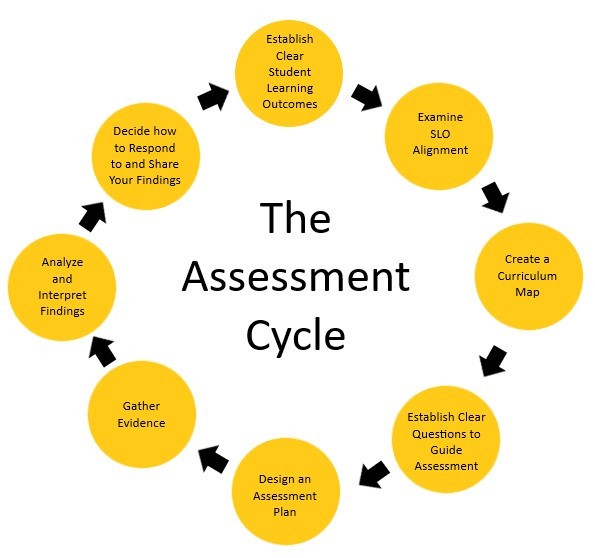The Program Assessment Cycle

Department and program faculty first agree on what it is that students should learn, or what students graduating from their program should be, know, or be able to do. Each department or program then develops clearly written and agreed upon Program Learning Goals and Outcomes.
Alignment is the process of ensuring that course learning outcomes, program learning outcomes, and institutional goals (such as the UW System Shared Learning Goals) correspond with one another. Individual faculty are responsible for ensuring alignment with program goals in their courses, although the program as a whole is responsible for ensuring overall alignment with institutional goals.
Creating a curriculum map allows programs to ensure that each program goal and outcome is adequately addressed throughout the course of study. It clarifies which courses are responsible for delivering opportunities and content to help students achieve particular outcomes. The curriculum map helps ensure that desired program skills or knowledge are introduced, re-affirmed, and developed across multiple required courses.
Good assessment plans begin by asking clear and specific questions that reflect faculty concerns and values. The most basic assessment question present in all program assessment plans is “What, or to what degree, have our students learned?” Faculty may design assessment plans that also address more specific programmatic questions about the factors and conditions affecting student learning, such as how a new curriculum is affecting student test scores, or if a curriculum is working equally well for different student populations in the program.
The program assessment plan is designed to gather evidence to evaluate the health or effectiveness of the program, and is different than student assessment. While student assessment asks if a student has demonstrated a skill or learning sufficiently to pass, graduate, or earn a particular grade, program assessment uses indicators (which may include student assessment results) to evaluate the program. Each program determines what kind of evidence will best illuminate their assessment questions. Assessment plans include establishing targets for acceptable program outcomes, and accounts for what kind of evidence is needed and how to gather that evidence with available resources.
Programs and courses already produce evidence of learning. The most sustainable assessment plans capitalize on embedded assessment, by capturing and evaluating student work already being produced in a way that allows it to be aggregated for program assessment purposes. Evidence can be direct or indirect and should be appropriate to what is being assessed.
Data rarely speaks for itself. Programs and faculty work to make sense of their assessment data, whether qualitative or quantitative, and determine what their results mean in the local context of their program. That process can be collaborative, or programs may designate qualified faculty or staff to examine assessment data, contextualize it, and explore what conclusions can be drawn.
The results of program assessment are first, and most importantly, shared with program faculty to determine what response is needed and to develop an action plan to implement the response. Assessment data highlights program successes and strengths, while also helping faculty identify needed changes in curriculum, professional development, academic support structures for students, or even in the assessment plan itself. As part of the accreditation process, programs report their assessment activity, data, and resulting action plans to Academic Affairs using WEAVE.